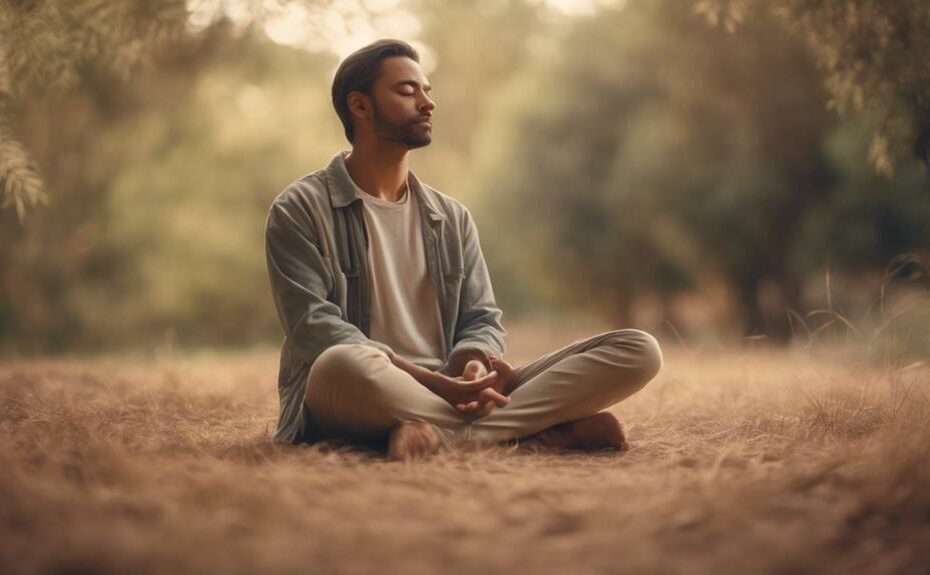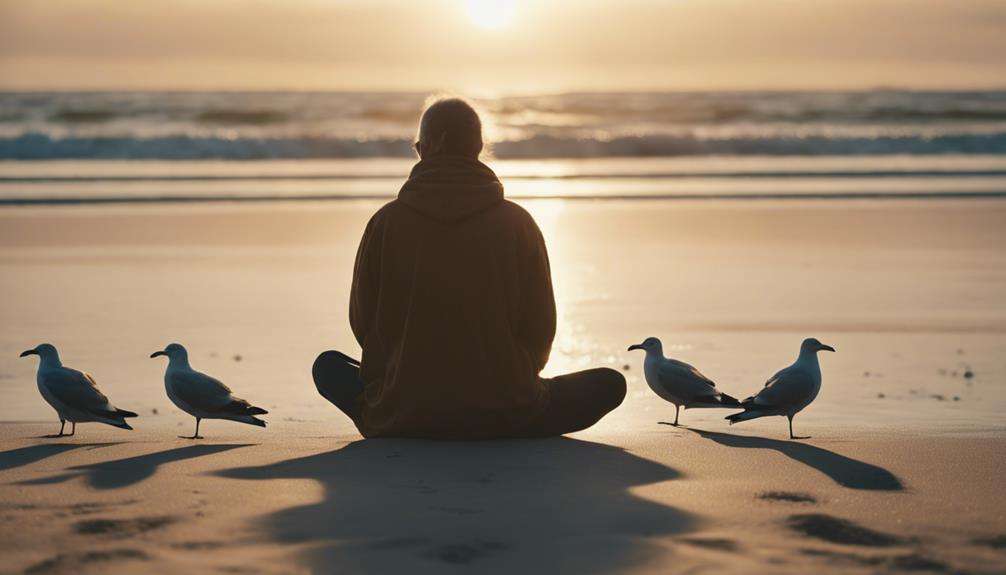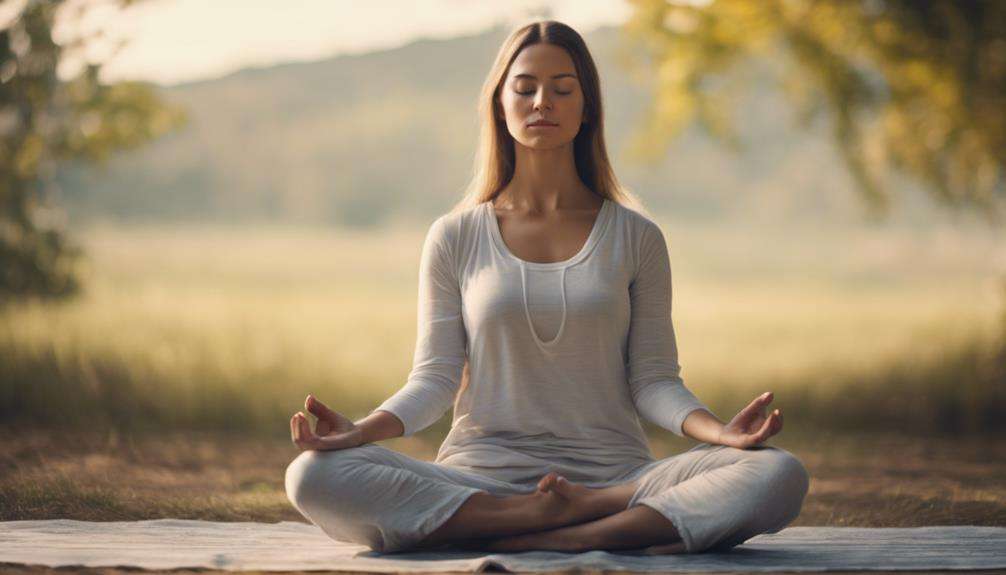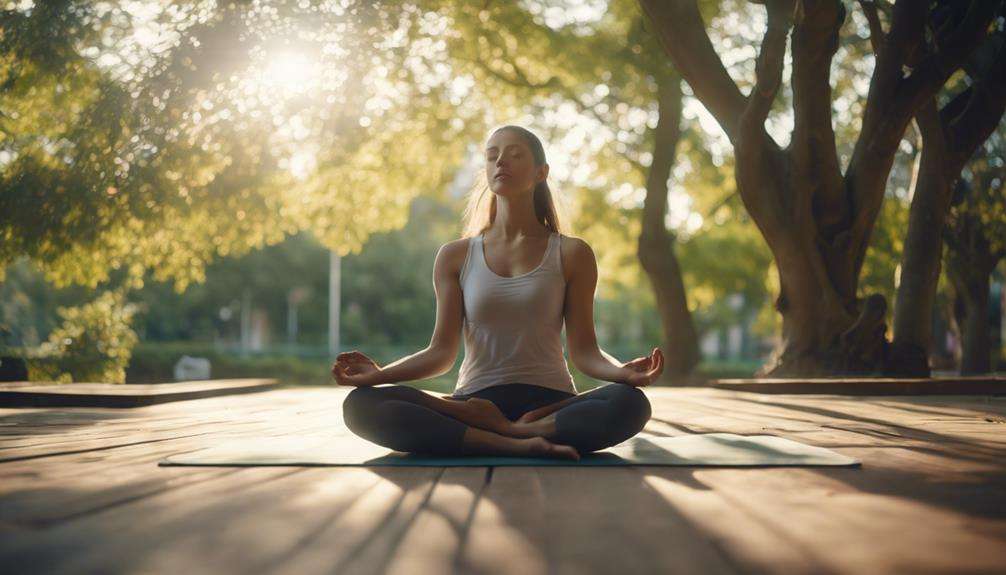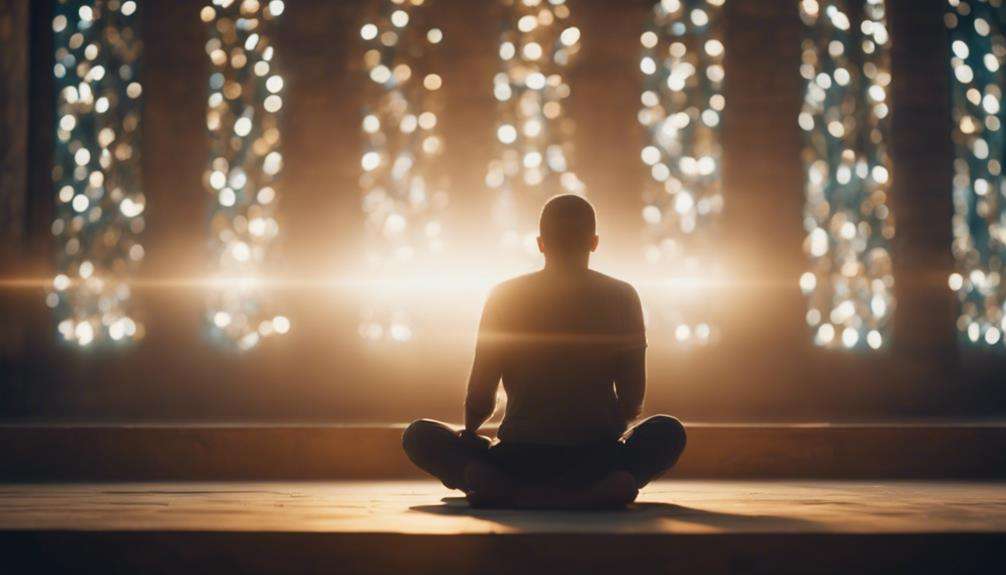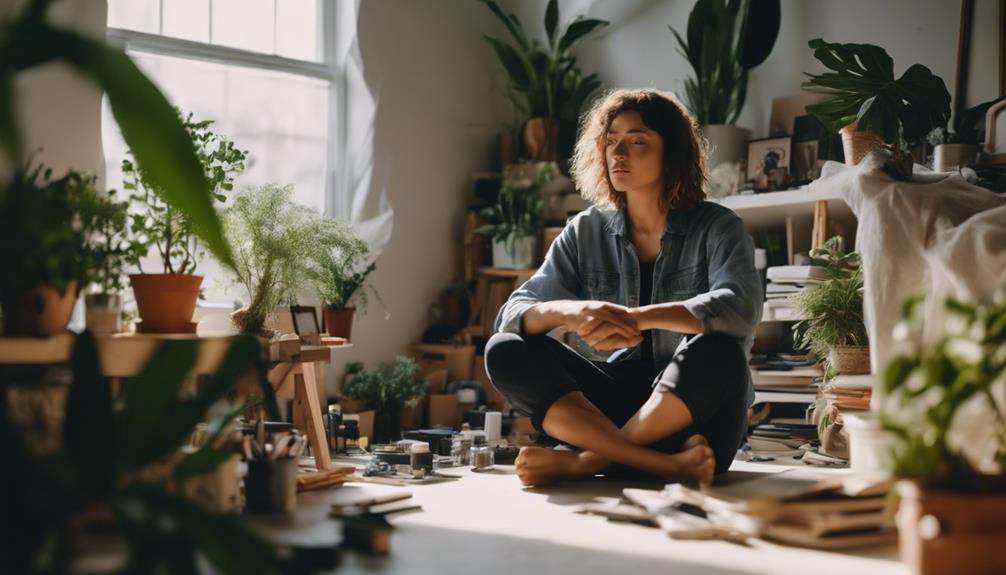If you're skeptical about the effectiveness of yoga poses in relieving anxiety and tension, consider this – the mind-body connection in yoga can work wonders for your mental well-being. Imagine being able to unwind and destress through simple yet powerful poses.
As you explore the top yoga poses tailored to alleviate anxiety and tension, you'll discover practical techniques that can significantly impact your daily life. Stay tuned to uncover how these poses can bring a sense of calmness and serenity to your hectic routine.
Key Takeaways
- Reduce anxiety and tension with targeted neck stretches and shoulder relief.
- Enhance spinal flexibility and strength with poses focusing on back muscles.
- Improve lower body flexibility and stress relief through targeted stretches.
- Foster mind-body connection and inner peace with poses promoting relaxation and well-being.
Seated Neck Stretch
If you're feeling tension in your neck and shoulders, try the Seated Neck Stretch to release stiffness and promote relaxation. This gentle stretch targets the neck muscles, helping to release tension and reduce discomfort. By practicing the Seated Neck Stretch, you can improve flexibility in your neck and shoulders, enhancing your range of motion and overall comfort.
Many individuals experience headaches and neck pain due to stress or poor posture. The Seated Neck Stretch can be a simple yet effective way to alleviate these symptoms. By elongating the neck muscles through this stretch, you can also work towards improving your posture and decreasing the risk of muscle strain in the future.
Incorporating the Seated Neck Stretch into your routine regularly can contribute to enhanced relaxation and the release of built-up tension in your upper body. Remember to breathe deeply and listen to your body as you perform this stretch to maximize its benefits for your well-being.
Cat Pose
Feeling tension in your neck and shoulders? Let's now explore the Cat Pose, a beginner-friendly yoga posture that enhances spinal flexibility and strengthens back muscles. Cat Pose, also known as Marjaryasana, is a fundamental yoga pose that focuses on the alignment of your spine and the engagement of your back muscles. By practicing Cat Pose regularly, you can increase the flexibility of your spine, which is crucial for reducing stiffness and discomfort in your back. This pose not only helps in physical aspects but also aids in relieving stress and tension by incorporating mindful breathing techniques.
When performing Cat Pose, focus on arching your back upwards while tucking your chin towards your chest. Feel the stretch along your spine and engage your core muscles to support your movements. This posture encourages you to be mindful of your body's alignment and movements, promoting a healthier posture over time. By incorporating Cat Pose into your yoga routine, you can cultivate a sense of relaxation and release built-up tension in your back muscles. So, take a moment to breathe deeply, elongate your spine, and feel the benefits of this rejuvenating yoga pose.
Cow Pose

To enhance your back flexibility and promote abdominal organ stimulation, let's delve into the gentle yet effective Cow Pose, also known as Bitilasana. This yoga pose involves arching your back and lifting your chest, providing various benefits for your body. Here's why incorporating Cow Pose into your practice can be advantageous:
- Stimulates Abdominal Organs: Cow Pose helps in stimulating the abdominal organs, aiding digestion and potentially relieving back pain.
- Increases Spinal Flexibility: By stretching the spine and opening the chest, Cow Pose enhances spinal flexibility, contributing to better posture.
- Strengthens Back Muscles: Regular practice of Cow Pose can help strengthen your back muscles, supporting overall back health.
- Energizes the Body: This pose can help energize your body, preparing it for further movements and poses in your yoga routine.
- Promotes Better Posture: By improving back flexibility and strengthening muscles, Cow Pose can contribute to better posture over time.
Incorporating Cow Pose into your yoga practice can bring about a sense of rejuvenation and physical well-being.
Extended Puppy Pose
Gain a sense of calm and release tension in your upper body with the gentle and soothing Extended Puppy Pose, Uttana Shishosana. This pose is particularly beneficial for those experiencing anxiety and stress as it stretches the spine, opens the chest, and relieves tension in the shoulders and upper back. By practicing Extended Puppy Pose, you can promote relaxation and enhance your overall well-being.
As you gently stretch your shoulders, arms, and upper back in this pose, you allow for the release of mental tension and fatigue. The elongation of the spine and the opening of the chest help in reducing anxiety-related tightness and creating a calming effect on the mind. Regular practice of Extended Puppy Pose not only improves your posture but also decreases stiffness in the upper body, contributing to feelings of relaxation and peace.
Embrace this pose as a tool to soothe your mind and body, fostering a sense of tranquility and inner balance.
Half Splits
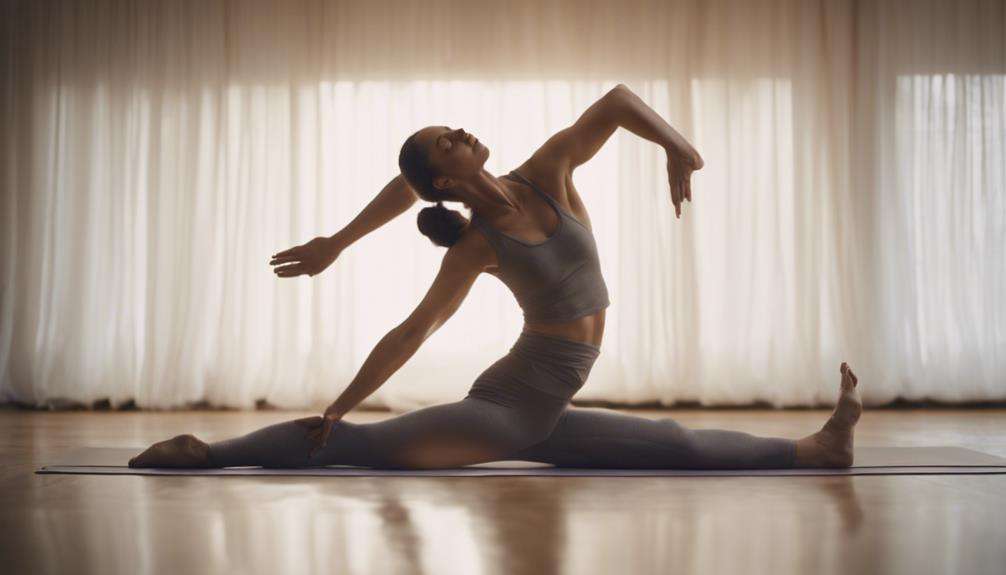
Ready to explore the benefits of Half Splits?
Let's talk about proper alignment tips and breathing techniques to make the most of this pose.
Benefits of Half Splits
Curious about how Half Splits can help your body and mind find balance and relief? Half Splits, also known as Ardha Hanumanasana, offer a range of benefits for both your physical and mental well-being. Here's what you can expect:
- Deeply stretches the hamstrings and calves, improving flexibility in these areas.
- Enhances flexibility in the hips and lower back, reducing tension and tightness.
- Helps release stress and anxiety, promoting relaxation through mindful stretching.
- Increases blood circulation to the legs, reducing muscle stiffness and discomfort.
- Proper alignment in Half Splits aids in improving posture and balance, contributing to overall physical well-being.
Try incorporating Half Splits into your yoga routine for a soothing and invigorating practice.
Proper Alignment Tips
For proper alignment in the Half Splits pose, ensure your front leg is straight with toes flexed towards the ceiling. Keep your hips squared and facing forward to deepen the hamstring stretch effectively. Engage your core muscles throughout the pose to protect your lower back.
If needed, use yoga blocks under your hands for support and maintain proper alignment. Focus on lengthening your spine and reaching your chest forward to maximize the stretch in Half Splits.
Breathing Techniques for Half Splits
To enhance your experience in the Half Splits pose and deepen your practice, incorporating proper breathing techniques is key. Here are some helpful tips to optimize your breathing while in Half Splits:
- Focus on deep inhalations and exhalations to release tension in the hamstrings.
- Breathe consciously to improve flexibility and promote relaxation in the pose.
- Use your breath to reduce anxiety and increase overall well-being during Ardha Hanumanasana.
- Utilize props like blocks or blankets to support your body and enhance muscle tension release.
- Remember that proper breathing not only aids in physical benefits but also contributes to mental calmness and peace.
Practice these breathing techniques to make the most of your Half Splits pose.
Seated Forward Bend
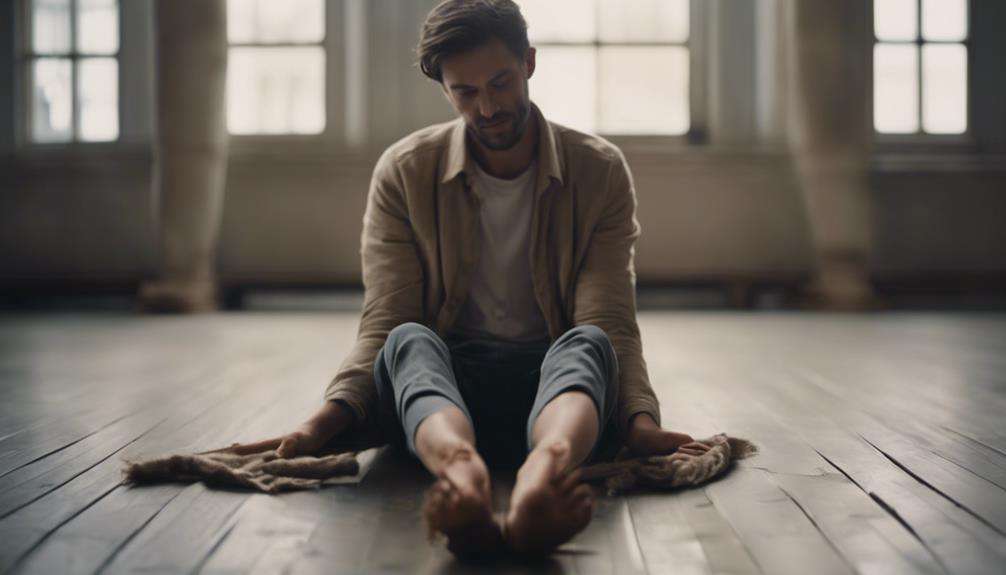
Stretching your spine, shoulders, and hamstrings, Seated Forward Bend, also known as Paschimottanasana, is a soothing yoga pose that can help alleviate stress and anxiety by promoting relaxation. By practicing Paschimottanasana, you can't only stretch your muscles but also calm your mind and relieve stress, allowing for a sense of peace and tranquility. This pose is particularly beneficial for improving digestion as it stimulates the liver, kidneys, ovaries, and uterus, aiding in relieving menstrual discomfort. Moreover, regular practice of Seated Forward Bend can help combat fatigue and insomnia, promoting overall well-being.
To fully experience the benefits of Paschimottanasana, remember to approach the pose mindfully and gently. Focus on your breath as you fold forward, allowing your body to relax into the stretch. Be mindful of any limitations and avoid pushing yourself too far to prevent strain or injury. Embrace the calming nature of Seated Forward Bend and let go of any tension as you breathe deeply and surrender into the pose.
Constructive Rest
As you transition from the Seated Forward Bend, find comfort and relaxation in the restorative yoga pose known as Constructive Rest. This gentle posture is a powerful tool to release tension, calm the mind, and reduce stress.
Here's why you should incorporate Constructive Rest into your practice:
- Improving Well-being: By allowing your body to rest in this position, you can improve your overall well-being and promote a sense of deep relaxation.
- Relieving Lower Back Pain: Constructive Rest helps in relieving lower back pain by promoting a natural alignment of the spine and allowing the muscles to relax.
- Increasing Mindfulness: This pose enhances body awareness and increases mindfulness as you focus on the sensations in your body.
- Supporting Emotional Healing: Practicing Constructive Rest regularly can support emotional healing by creating a safe space for introspection and relaxation.
- Enhancing Body Awareness: By lying down with knees bent and feet hip-width apart, you can tune into your body's needs and sensations, fostering a deeper connection with yourself.
Supine Spinal Twist
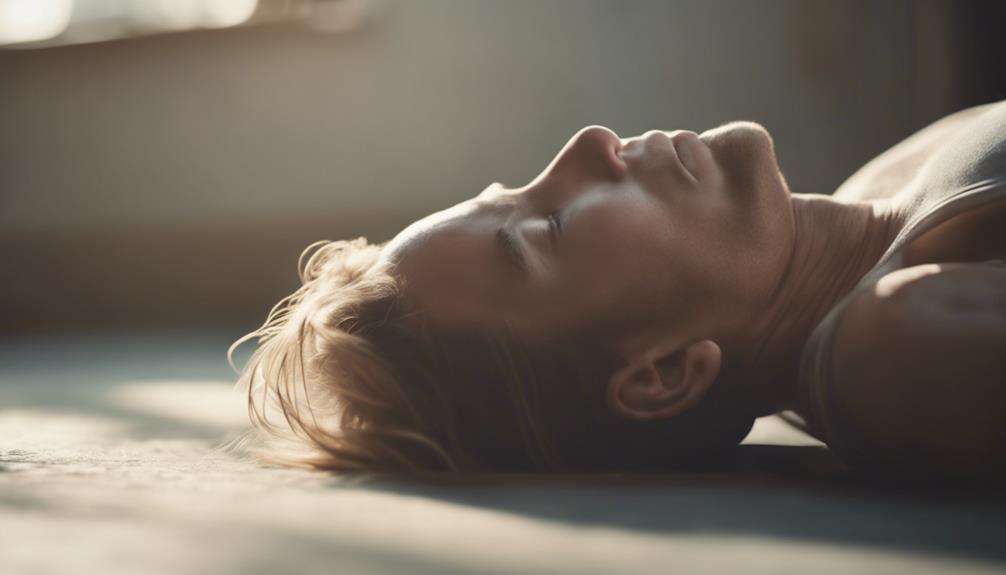
When you practice the Supine Spinal Twist, you're giving your spine a chance to unwind and relax, which can help alleviate stress and tension.
This pose offers benefits like improved spinal flexibility and a gentle stretch for your back muscles, promoting a sense of well-being.
Remember to breathe deeply as you hold this pose to enhance its calming effects and reap its full rewards.
Twist for Relaxation
For a soothing release of tension and stress, consider incorporating the restorative yoga pose known as Supine Spinal Twist into your practice. This twisting pose targets the spine and lower back, promoting flexibility and improved circulation to relieve discomfort and aid digestion.
By gently twisting, you can alleviate stress and calm your mind, fostering relaxation and overall well-being. To perform the Supine Spinal Twist correctly, lie on your back, bring your knees to your chest, then let them fall to one side while keeping your shoulders grounded. Hold the pose for a few breaths before switching sides. Make this pose a regular part of your routine to experience its full benefits.
- Targets spine and lower back
- Improves flexibility and circulation
- Aids digestion and relieves discomfort
- Alleviates stress and calms the mind
- Promotes overall well-being
Benefits of Pose
To experience the numerous benefits of the Supine Spinal Twist pose, focus on releasing tension in your spine and lower back muscles through gentle twisting and stretching. This pose helps improve flexibility in your spine, promoting spinal health and relieving discomfort.
By stretching your chest, shoulders, and back, you can release tightness and enhance mobility. Additionally, the Supine Spinal Twist aids digestion, alleviating any digestive issues you may experience.
Regular practice of this pose can also promote relaxation and reduce anxiety levels, providing a calming effect on both your body and mind. Embrace the soothing benefits of the Supine Spinal Twist to nurture your spine, enhance flexibility, and foster a sense of inner peace.
Frequently Asked Questions
Which Yoga Is Best for Stress and Anxiety?
When it comes to stress and anxiety, yoga offers a variety of calming practices. Focus on breath awareness, gentle stretching, and grounding techniques for muscle relaxation. Embrace the mind-body connection, calming postures, and meditation benefits for stress reduction and emotional release.
What Is the Most Relaxing Yoga Pose?
To experience ultimate relaxation in yoga, try Savasana. Lie down, arms and legs open, and let go. Breathe deeply, relax your mind, and release tension. It's a peaceful way to unwind and recharge.
Which Yoga Exercise Will You Practice if You Want to Be Relieved From Anxiety Stress and Tension Why?
When seeking relief from anxiety, stress, and tension, consider incorporating deep breathing. Engage in mind-body practices like gentle stretches, grounding poses, and meditation. These techniques aid in stress relief, promoting a calm mind, releasing shoulder tension, and soothing the nervous system.
Does Yoga Actually Help Anxiety?
Yoga does help anxiety by promoting relaxation through breathing techniques, mindfulness, and meditation. It enhances emotional balance, mental clarity, and overall stress reduction. Embrace yoga as a self-care practice for holistic healing and anxiety relief.
Conclusion
Take a moment to breathe deeply and relax.
By incorporating these yoga poses into your routine, you can effectively reduce anxiety and tension.
Remember, self-care is essential in managing stress.
So why not try practicing these poses today and see how they can benefit your overall well-being?
You deserve to feel calm and at peace.
Give yourself the gift of relaxation through yoga.
